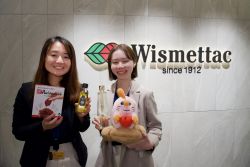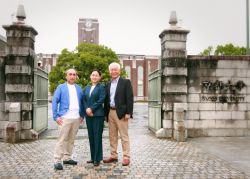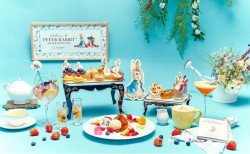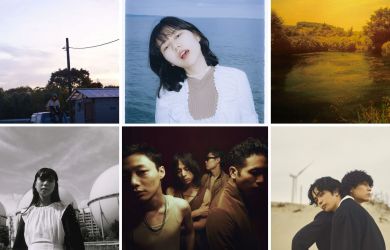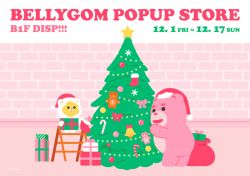
March 16, 2012
A Place In My Art
Finding space with Tokyo’s independent art entrepreneurs
By Metropolis
Originally published on metropolis.co.jp on March 2012

The first art gallery space as we know it is said to be the Palais du Louvre, opened as a museum in 1793 by the French Revolutionary government. By 1863, sufficient opposition to the narrow views of the artistic establishment led to the opening of the Salon des Refusés featuring work by “rejected” artists. This process occurred in Japan, too, with the Meiji government’s first western-style exhibition, the Bunten, quickly garnering criticism as being élitist and conservative. Since then, Japan’s artistic reactions against the establishment have taken different forms, like the mass production of socially critical art magazines in the early 20th century, and avant-garde movements such as the Hi-Red Center in the ’60s, who responded to the government’s pre-Olympics clean-up of the city by heading out in white suits to “clean” it themselves.
Today, the élitist and conservative tags have given way to a charge that the main galleries in Tokyo only pander to big names from overseas—or Japanese artists who have proven themselves in other countries. Emerging and mid-career artists can rent gallery spaces for their exhibitions, but this is pricy, and they will probably only reach a limited audience of friends and contacts.
Those familiar with the thriving independent art projects of London or New York might be surprised to come across fewer such ventures here in Tokyo. A common refrain from new artistic entrepreneurs is that the Tokyo scene is “too clean.” So at least, says Julien Sato, co-founder of M (Event Space & Bar), a combined arts space in Daikanyama. Sato points at the graffiti on the bar by Japanese artist Must. “That kind of thing is street art in other countries,” he says. “Here in Japan there is very little space for that kind of expression.” M, he hopes, can offer one.

Israeli maverick curator Shai Ohayon began running his successful Toronto event ArtGig in Tokyo for much the same reason. During his time working in London, among other things using the historic Bishops of London residence, Fulham Palace, which was refurbished by the Heritage Lottery Fund as a contemporary gallery space, he didn’t feel the need to organize any of his notorious art installation and music marathons. “London is dirty enough already—they don’t need my dirt on top of it,” he laughs. “But Tokyo really needs it.”
During his time working with bureaucracy and red-tape in London, Ohayon “realized that restrictions can make you more creative.” Putting this to the test he began to curate The Container, a gallery that is literally a shipping container inside Bross Hair Salon in Daikanyama. There, he runs four exhibitions a year, of which the enjoyable part is working out how to integrate them into the limited space.
This issue of art and space in Tokyo is, of course, influenced by the restrictions imposed by one of the most expensive cities in the world.
Tamura took the notion to the extreme by opening Tana Gallery Bookshelf on the bookshelf of Bigakko art workshop in Jimbocho, renting the space for ¥2,000 a month—a symbolic rental agreement that he only ever paid once. “People might say it’s small, but I don’t think it’s small,” he says. “It’s an adequate space if you want to have an independent art space in Tokyo—in terms of the financial conditions.”
The gallery has had various experimental exhibitions that are interesting precisely because they have to deal with such a limited area. The current work is “Klangstube” by German artist Florian Haupt, which is a moving contraption that makes a variety of noises, and which visitors are encouraged to push and pull the buttons of to alter the sound and movement.
Brad Bennett, an American photographer, cyclist, and tour guide amid many other passions, hopes his new arts space in Sasazuka, Studio C—home of live music events, art and photography exhibits, art classes for kids, artisanal workshops and more—can provide a platform for collaboration. Bennett funds the space, for example, by hiring it out as a studio, or allowing teachers to rent the space or pay a percentage. This allows for Studio C’s free monthly art events, and regular exhibitions such as experimental photo exhibit “Sparks” by Ken Iwai.
Well-known arts and music space SuperDeluxe in Nishi-Azabu was founded ten years ago, and they also host corporate events to allow for other more artistic happenings that would probably not reap financial rewards. “People always say to me that in any other country we would benefit from some kind of governmental support for the work we do,” points out co-founder Mike Kubeck. By providing spaces for lesser-known artists, without the resources, contacts or know-how to make it big, are spaces like SuperDeluxe confronting the startling lack of institutional arts funding in Japan? “We’re not consciously doing that,” replies Kubeck. “We are primarily motivated by what interests us. If that has the effect of plugging the gap then that is great.”
Other alternative art spaces…
- SCAI the Bathhouse This Yanaka gallery in a 200-year-old bathhouse supports avant-garde and emerging artists. Closed for installation. www.scaithebathhouse.com
- 3331 Chiyoda Based in a done-up high school, 3331 blends cutting edge and day-to-day in a free-to-enter gallery and arts center. www.3331.jp
- Tokyo Wondersite In three central Tokyo locations, TWS nurtures young talent in various fields through residences and other programs. www.tokyo-ws.org
- Kid Ailack Hall With a name meaning joy, anger, sorrow and humor, Kid Ailack offers live painting, poetry, performance, buyo dance, etc. to stimulate these emotions. Founded in 1964, it is one of the oldest shared arts spaces in Tokyo. www.kidailack.co.jp
M employs a similar system. Set up by 30-year-old Japanese-French twins Julien and Kenji Sato, along with Japanese associate Yoneda Norifumi, it was a natural follow-on from the brothers’ work running arty PR events for companies such as Perrier. “Our idea was to take underground artists from Japan and overseas and bring them out.” In December 2009, they founded M Space to separate the artistic side from the PR event organizing side, using one to fund the other.
The idea of M is a neutral platform. “Even the name “M” can mean whatever you want it to mean,” says Sato. The layout is minimal with comfortable furniture that makes people feel at home, while being easily rearrangeable for different events. The space has a rotating gallery of works by international and Japanese artists, and has brought DJs, musicians, live painters, dancers and more within its walls to reach new vistas through collaboration. As in Studio C, where Bennett says, “I don’t consider myself a qualified curator but I do know something good happens when people get together.”
That is the thinking behind SuperDeluxe, too. Kubeck refers to the “cross-pollination” that takes place when creative people get together—no matter their favored medium. This is something the founders learned working in a shared office space, formerly a taxi garage, in Azabu-Juban called “Deluxe,” where they would host monthly experimental music events. “In a shared office you can get stuck on your own stuff, only to find the solution by spending time with people engaged in something totally different,” says Kubeck. “The energy and buzz make everyone more than the sum of their parts.”
But the space needs to exist for these disparate forces to come together. “Artists could be doing something vital and significant in their own world but never get outside that,” explains Kubeck. As “curator,” SuperDeluxe has brought many of these people outside their worlds to create something marvelous together. A prime example is slated for May 10-13, when a performance and exhibition will bring together underground manga artist Toyo Kataoka with experimental theatre troupe Crack Iron Albatrossket.
Funky artist collective Shibuhouse push this collaborative ideal to the extreme by living together. Their house in Shibuya where 17 residents currently lay their head (most of them in the same room), boasts painters, musicians and a theater director among its gang. There, they live and breathe art among a stupendous manga, DVD and game collection, and host various events such as monthly parties with DJs in the basement and live painting on the roof. Like the Sato brothers, Shibuhouse founder Keita Saito was working in art PR when he had the idea. “The Tokyo art scene is not interesting,” he says. “The problem is the Edo Period was too good, we can’t compete.”

According to Saito, Shibu House is the only place of its kind in Tokyo, and the lack of this kind of artist-run residence here is what surprises Ohayon, who is planning to host an exhibition of Shibuhouse in The Container next year. The current exhibition is a haunting video installation by UK artist Ami Clarke, “Be Seeing You,” which makes use of footage from cult TV series The Prisoner. The black and cramped shipping container focuses attention on the flashing images, while noises and smells wafting in from the surrounding hair salon serve to further increase one’s disorientation.
So by experimenting with how art should be produced, displayed and experienced, are these initiatives changing the face of Tokyo art? Masamichi believes that these kinds of spaces were always there, though he concedes that Tana Gallery Bookshelf and The Container are two of very few spaces of their kind right now. Shibu House’s uniqueness, on the other hand, could influence other artist-run residences of this kind. Ohayon, for his part, believes a change might be nigh, owing in part to the tragic disasters of March 11, 2011. “3/11 facilitated something,” he says. “People became more aware of political matters, started organizing things themselves.”
In the end it is that reliance on one’s own projects that is essential for this breed of Tokyo artistic pioneers. This is what Kubeck calls a “punk esthetic,” the DIY nature of an art that people do themselves, without worrying about institutional support or any other considerations. This keys into the purpose of art itself, according to Masamichi. “Art can do something independent of the dominant logic in the market.” And if you are keen on stepping outside of that dominant logic, these spaces might be a good place to start.
See highlighted listings for details of upcoming events at these venues, and check their homepages for more info:
- M (Event Space & Bar) www.m-event-bar.com
- Shibuhouse, www.shibuhouse.com
- Studio C http://studioctokyo.core.ne.jp
- The Container, http://the-container.com
- Tana Gallery Bookshelf http://rad-commons.main.jp/tana
- SuperDeluxe www.super-deluxe.com
